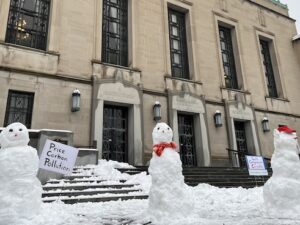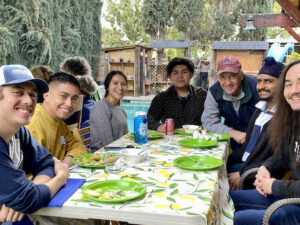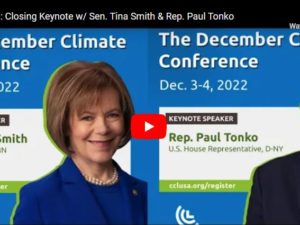
Pat Fettes (right) spearheaded some incredible media work across Minnesota
CCL Minnesota’s statewide campaign for clean energy media hits
By Charlotte Ward
Clean energy is affordable, reliable, and safe — that’s the message CCL volunteers set out to convey through a local media drive to publish LTEs and op-eds in every congressional district in Minnesota.
Using the media lever, the team of writers, led by CCL Northland chapter member Pat Fettes, vowed to complete the challenge in time for CCL’s 2024 Summer Conference and Lobby Day. They smashed their goal — printing 46 letters in 26 different publications, across all eight Minnesota congressional districts, by the time the June conference came around.
“We all want energy that is affordable, reliable, and safe,” says Pat. “But some Minnesota residents and political leaders are concerned that a timely transition away from fossil fuels could lead to power outages and high energy costs. We wanted to correct this misunderstanding and make it clear that we can transition to clean energy without sacrificing reliability, safety and affordability.”
Instructions for the CARS Project — promoting Clean, Affordable, Reliable, and Safe energy — were posted on a helpful website along with talking points and links and a map outlining where volunteers were getting published.
“The website is a one-stop shop to share examples of letters to the editor, links to newspapers in every county, helpful LTE resources, and to keep track of the progress we’re making,” explains Pat.
To date, successes have been published in newspapers ranging from the large Minneapolis Star Tribune and St. Paul Pioneer Press to smaller, local outlets like the Swift County Monitor-News and the Isanti-Chisago County Star. This ensures the writing team are able to communicate to a huge number of Minnesotans as well as their elected officials.
During CCL’s Lobby Day in June, volunteers shared the project with their congressional offices to let them know that it’s not just a few people in Minnesota’s major cities that are concerned about climate, but throughout the entire state. Citizen lobbyists provided a one-pager with a link to a public-facing website that included all published letters.
“We could see that it really made an impression on congressional offices that we have the capacity to mobilize statewide on clean energy,” adds Pat. In recent months, she has extended the project to ensure that both big and small newspapers are covered in each district.
The letters are varied and creative in content. Some writers chose to focus on the financial or social rewards of transitioning to new energy sources, others on permitting reform and the value of financial incentives. But each published letter emphasized how critical it is for the state to transition to clean energy now.
Tried and true tactics
It’s not the first time Minnesota volunteers have successfully used local media to build political will for clean energy and legislation to reduce carbon emissions. In the first half of 2022, volunteers published LTEs in all 87 counties in Minnesota advocating for climate solutions, particularly a price on pollution with the money recycled back to Americans.
In the second half of that year, they met their goal again publishing LTEs to build community support for the Inflation Reduction Act and educate about the bill’s beneficial climate components across the state.
“We have learned a lot about being successful with a project like this,” says Pat. “Working with all Minnesota CCL chapters helped identify people who like to write or were willing to try a first LTE. Having a specific goal and a deadline were essential. A project website is not essential but it was very effective in keeping track of progress and providing resources for writers.
“We hope the project and website can be a model for other states or chapters and are happy to share it. I am indebted to Minnesota CCL members Katya Gordon and Mary Haltvick for their profound inspiration and assistance, and all the project writers for making it happen.”
Letters to the editor and opinion columns are a core way CCL members make sure their members of Congress and the local community understand the value of clean energy solutions. To find out more about writing your own LTEs, be sure to check out CCL’s Media Resources trainings and join the CCL Writers Circle.
Highlights from the campaign
From Cheryl Campbell, Minnesota Congressional District 1. Published in the Rochester Post-Bulletin, April 6, 2024.
“A smartly implemented carbon tax can create resilient domestic clean energy supply chains. That means jobs, which should appeal to both sides of the political spectrum. This tax need not “disappear” into public coffers. Tax proceeds could go towards electrical grid modernization, household rebates, training, or be redistributed to citizens as a tax credit (much as Alaska pays its citizens a “dividend” based on oil taken out of the ground). There are many tax policies that drive business decisions: tariffs, equipment depreciation, credits for technology adoption, and Opportunity Zones are but a handful. Let’s not take away carbon taxes as a tool for U.S. industrial policy!”
From Howard White, Congressional District 2. Published in the Northfield News, January 18, 2024.
“We can have an impact on our climate and individual actions help. Over 16 years, and it took that long a time to make it affordable for us, my wife and I have replaced our windows, added solar panels, re-did the insulation in our house’s walls and attic, bought an EV, and most recently, installed an air source heat pump to replace our AC and lessen the use of our gas-powered furnace. We reduced our carbon footprint. Now, there are tax credits and rebates making all these changes more affordable.”
From Earl Knutson, Congressional District 6. Published in the West Central Tribune, March 13, 2024.
“In 2015, the city set a goal of sourcing 25% of the electricity needed to operate the city government from renewable sources by 2020. In fact, by 2020, they had blown way past that goal — all of the city government’s electricity was from renewable sources… Any notion that St. Cloud is a staid, risk-averse city has been turned on its head. Future goals: all city electricity to be renewable by 2028; the entire city to be carbon-free by 2038.”
From Dave Homans, Congressional District 8. Published in the Cook County News Herald, February 17, 2024.
“You might think that living in the northland, we won’t be much affected by climate warming. Not so. We’re actually warming faster than many other parts of the earth…We don’t have to sit helplessly watching our way of life melt away. The Energy Innovation and Carbon Dividend Act (H.R.5744) charges corporate polluters a fee for the carbon emissions they put into our air. The money collected goes to regular Americans in the form of a monthly ‘carbon cashback’ payment to keep things affordable.”





